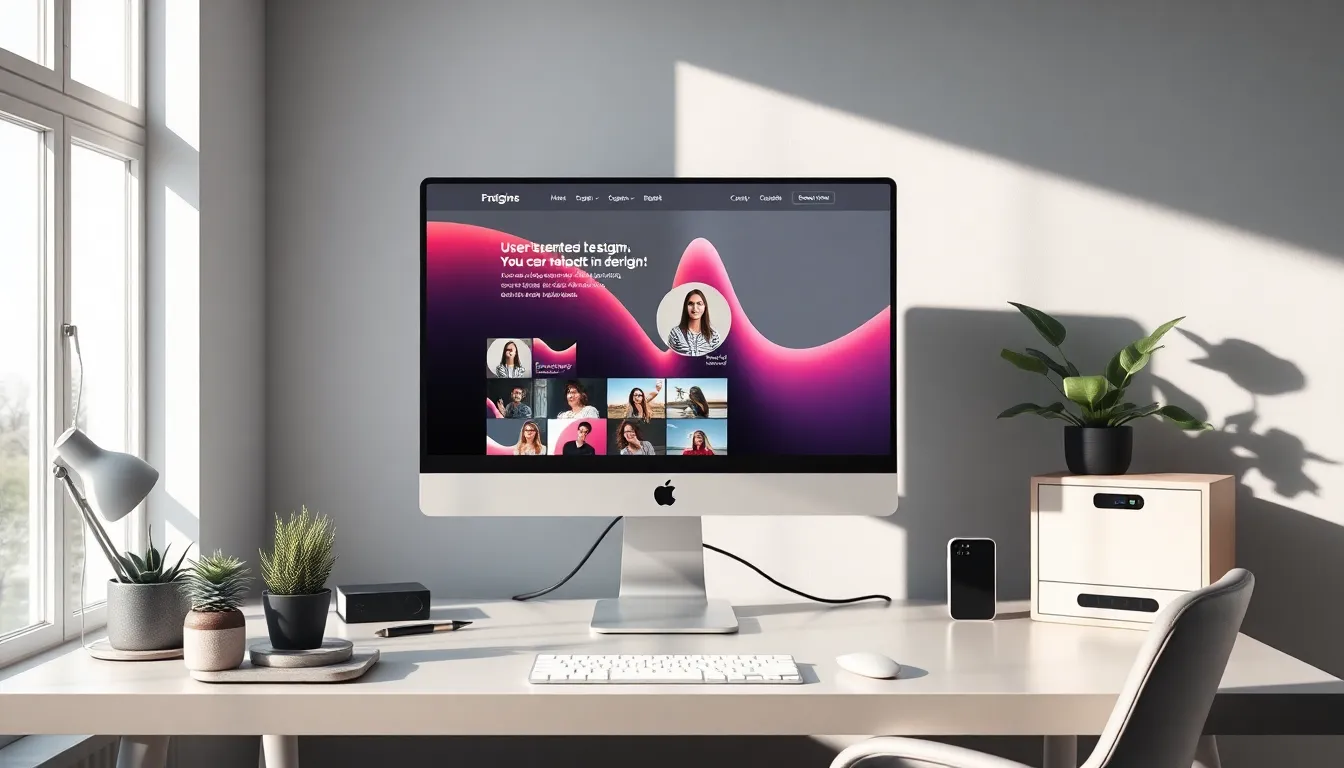In today’s digital landscape, modern web design plays a crucial role in shaping user experiences and driving engagement. As technology evolves, so do the expectations of users who demand visually appealing, intuitive, and responsive websites. Designers now face the challenge of balancing aesthetics with functionality to create sites that not only look good but also perform seamlessly across all devices.
The principles of modern web design go beyond mere visuals. They encompass user-centered approaches, accessibility, and the integration of innovative technologies. From minimalist layouts to dynamic content, understanding the latest trends is essential for anyone looking to make an impact online. Exploring these elements can help businesses and individuals alike craft compelling digital experiences that captivate audiences and foster loyalty.
Table of Contents
ToggleOverview of Modern Web Design
Modern web design focuses on creating websites that enhance user experience and engagement through visual appeal and functionality. Designers aim to meet evolving user expectations by integrating intuitive navigation, responsive layouts, and aesthetic elements that draw attention. Balancing visual elements with practical applications forms a fundamental aspect of the design process.
Key principles of modern web design include:
- User-Centered Design: Prioritizing user needs ensures that websites are intuitive and easy to navigate. Gathering user feedback during the design process significantly improves the final product.
- Accessibility: Ensuring that websites are usable by individuals with varying abilities broadens audience reach. Adhering to Web Content Accessibility Guidelines (WCAG) helps create a more inclusive web environment.
- Innovative Technologies: Utilizing cutting-edge technologies such as AI, VR, and AR enhances interactivity and engagement. These innovations help create immersive experiences that attract users.
- Responsive Design: Implementing flexible layouts accommodates different screen sizes and devices. This adaptability maintains usability across smartphones, tablets, and desktops.
- Minimalist Aesthetics: Using clean, uncluttered designs improves focus on content. Minimalism often involves strategic use of whitespace and a limited color palette to enhance readability.
Understanding current trends such as dynamic content, motion graphics, and personalized experiences can significantly impact website effectiveness. Designers equipped with this knowledge can create impactful digital experiences that resonate with users and foster long-term engagement.
Key Principles of Modern Web Design

Modern web design focuses on creating user-friendly and visually appealing experiences. Several key principles guide designers in achieving these goals.
User-Centered Design
User-centered design emphasizes understanding users’ needs and preferences. Designers gather feedback through usability testing and surveys to refine website features. Prioritizing user experience increases engagement, leading to higher satisfaction rates. Incorporating intuitive navigation allows users to find information quickly. Personalization enhances relevance, ensuring users interact with content that resonates with them.
Responsive Design
Responsive design ensures optimal viewing across various devices, including desktops, tablets, and smartphones. Fluid grids and flexible images adjust layouts to fit different screen sizes seamlessly. Media queries enable styles to change based on device characteristics, maintaining functionality and aesthetics. This adaptability improves accessibility and significantly enhances user experience. Increased mobile usage highlights the necessity of responsive design for maintaining traffic and reducing bounce rates.
Minimalism and Aesthetics
Minimalism in web design prioritizes simplicity and clarity. By reducing clutter and focusing on essential elements, designers enhance content visibility. A clean layout improves navigation, allowing users to absorb information efficiently. Aesthetic choices, including color schemes and typography, contribute to a cohesive brand identity. Visual hierarchy guides user attention toward key content, improving engagement. Balancing aesthetics and functionality creates an inviting and effective online presence.
Trends in Modern Web Design
Modern web design evolves rapidly, reflecting user preferences and technological advancements. Several trends currently shape the landscape of web design, enhancing user experience and engagement.
Microinteractions
Microinteractions refer to subtle design elements that engage users during specific actions. Examples include button animations, loading indicators, and notifications. These small interactions provide feedback, improving usability and satisfaction. Scheduled microinteractions create a more dynamic user experience by acknowledging user efforts and guiding them through tasks, such as form submissions or downloads.
Dark Mode
Dark mode presents a sleek interface option that reduces eye strain and saves battery life on OLED screens. Websites adopting dark mode typically feature darker backgrounds with lighter text, enhancing readability. Users can switch between modes to suit personal preferences, creating a customizable experience. Designers often integrate this feature alongside light mode for broader accessibility and appeal.
Asymmetrical Layouts
Asymmetrical layouts challenge traditional grid systems, allowing for unique and engaging designs. These layouts emphasize visual storytelling by creating focal points that draw attention to key content. Designers strategically use whitespace and overlapping elements to maintain balance while offering an unconventional viewing experience. Asymmetrical designs can enhance user engagement by encouraging exploration and interaction with various site elements.
Tools and Technologies
Modern web design relies on various tools and technologies that streamline the design and development process, improving efficiency and collaboration.
Design Software
Design software plays a crucial role in creating visually appealing websites. Popular options include:
- Adobe XD: Offers design and prototyping tools that enhance collaboration among teams.
- Figma: A web-based design tool that allows for real-time collaboration, making it easier to share feedback and iterate on designs.
- Sketch: Focuses on interface design, providing features for creating responsive layouts and vector graphics.
These tools support intuitive interfaces and incorporate advanced features like design systems that ensure consistency across projects.
Front-End Development Frameworks
Front-end development frameworks facilitate the creation of responsive and interactive web applications. Notable frameworks include:
- React: A JavaScript library for building user interfaces, emphasizing component-based architecture that boosts reusability.
- Angular: A comprehensive framework for dynamic web applications, offering robust features like two-way data binding and dependency injection.
- Vue.js: A progressive framework focused on building user interfaces, allowing for easy integration with existing projects.
These frameworks enhance productivity by providing pre-built components and optimizing performance for various devices.
Best Practices for Modern Web Design
- Prioritize User Experience
Build websites around user needs. Conduct usability testing to gather feedback, refine the design, and enhance satisfaction.
- Implement Responsive Design
Utilize fluid grids and media queries to ensure websites function seamlessly across devices. Focus on creating layouts that adapt to different screen sizes.
- Embrace Minimalism
Opt for a simple, clean design that eliminates clutter. This practice improves content visibility while ensuring easy navigation for users.
- Focus on Accessibility
Adhere to WCAG guidelines to ensure websites are usable for individuals with disabilities. Implement alt text for images, proper contrast ratios, and keyboard navigation.
- Utilize Microinteractions
Incorporate subtle animations and feedback mechanisms to enhance usability. Examples include simple button hover effects and notifications that guide user actions.
- Explore Asymmetrical Layouts
Challenge conventional design standards with unique layouts. Asymmetrical designs engage users through dynamic visual storytelling and promote exploration.
- Choose Aesthetic Consistency
Maintain a cohesive visual identity by selecting consistent color schemes and typography. Such choices contribute to brand recognition and enhance user engagement.
- Leverage Innovative Technologies
Integrate AI, VR, and AR to enrich user interactions. These technologies can create immersive experiences, drawing users into compelling storytelling.
- Select Efficient Design Tools
Use platforms like Adobe XD, Figma, and Sketch for collaborative design workflows. These tools streamline the design process, encouraging teamwork and creativity.
- Incorporate Front-End Frameworks
Implement frameworks like React, Angular, and Vue.js to simplify the development of responsive web applications. Such frameworks enhance performance across various devices.
Modern web design plays a crucial role in shaping user experiences in the digital landscape. By focusing on user-centered principles and embracing innovative technologies, designers can create engaging and functional websites that meet evolving user expectations.
Adopting best practices like responsive design and minimalism not only enhances usability but also fosters brand recognition. As trends continue to evolve, staying informed and adaptable is essential for designers aiming to create impactful digital experiences. Prioritizing accessibility and incorporating dynamic elements will ensure that websites remain relevant and appealing to diverse audiences.



